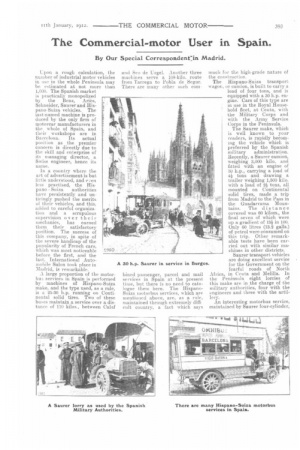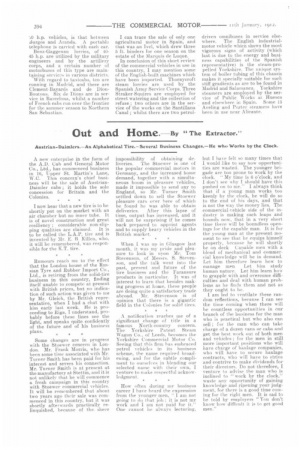The Commercial-motor User in Spain.
Page 13

Page 14

If you've noticed an error in this article please click here to report it so we can fix it.
By Our Special CorrespondenCin Madrid.
Upon a rough calculation, the number of industrial motor vehicles in use in the whole Peninsula may be estimated at not more than 1,000. The Spanish market is practically monopolized by the Benz, Aries, Schneider, Saurer and Hispano-Suiza vehicles. The last-named machine is produced by the only firm of motorcar manufacturers in the whole of Spain, and their workshops are in Barcelona. Its actual position as the premier concern is directly due to the skill and enterprise of its managing director, a Swiss engineer, hence its name.
In a country where the art of advertisement is but little understood, and e'ien less practised, the His
pano Suizit authorities have persistently and untiringly pushed the merits or their vehicles, and this, added to careful organiza. tion and a scrupulous supervision over their mechanics, has earned them their satisfactory position. The success of this company, in spite of the severe handicap of the popularity of French cars, Which was most noticeable before the first, and the last, International Automohile Salon took place in Madrid, is remarkable.
A large proportion of the motorbus services in Spain is performed by machines of Hispano-Suiza make, and the type used, as a rule, is a 25-30 h.p. running on Continental solid tires. Two of these buses maintain a service over a distance or 110 kilos., between Clalaf and Se° de lirgel. Another three machines serve a LOS-kilo. route from Tarrega to Pobla de Segur. There are many other such coin
bined passenger, parcel and mail services in Spain at the present time, but there is no need to catalogue them here. The HispanoSuiza motorbus services, which are mentioned above, are, as a rule, maintained through extremely diffi cult country, a fact which say
much for the high-grade nature of the cons traction. The liispano-Suiza transport wagon, or ca,mion, is built to carry a load of four tons, and is equipped with a 30 h.p. engine. Cars of this type are in use in the Royal Household fleet, at Ceuta, with the Military Corps and with the Army Service Corps in the Peninsula.
The Saurer make, which is well known to your readers, is rapidly becoming the vehicle which is preferred by the Spanish military administration. Recently, a Saurer camion, weighing 3,000 kilo. and fitted with an engine of 30 h.p., carrying a load of 44 tons and drawing a trailer weighing 1,500 kilo. with a load of 24 tons, all mounted on Continental solid tires, made a trip from Madrid to the Pass in the Guadarrama Moun tains. The di is tan c e covered was 60 kilom., the final seven of which were up a gradient of 134 in 100. Only 60 litres (13.2 galls.) of petrol were oonsumed on this trip. Other remarkable tests have been carried out with similar machines in other districts.
Saurer transport vehicles are doing excellent service for the Government on the fearful roads of North Africa, in Ceuta and Melilla. In the Peninsula eight lorries of this make are in the charge of the military authorities, four with the engineers and three with the artillery. An interesting motorbus service, maintained by Saurer four-cylinder,
1,0 h.p. vehicles, is that between riurgos and Aranda. A portable telephone is carried with each car.
Benz-Gaggenau lorries, of 4045 h.p. are utilized by the military engineers and by the artillery corps, and a certain number of motorbuses of this type are maintaining servics in various districts.
With regard to taxicabs, ten are running in Madrid, and these are Clement-Bayards and de DionBoutons. Six de Diana are in service in Barcelona, whilst a number of French cabs run over the frontier for the summer season to Northern San Sebastian. Jean trace the sale of only one agricultural motor in Spain, and that was an Ivel, which drew three ft. binders for one season on the estate of the Marquis de Luque.
In conclusion of this short review of the commercial vehicles in use in this country, I may mention some of the English-built machines which have been imported. Thornycroft steam lorries are used by the Spanish Army Service Corps. Three Straker-Squires are employed for street watering and the collection of refuse ; two others are in the service of the works on the Santillana Canal ; whilst there are two petrol driven omnibuses in service elsewhere. The English industrialmotor vehicle which shows the most vigorous signs of activity (which last is due to the energy and business capabilities of the Spanish representative) is the steam-propelled Yorkshire. The unique system of boiler tubing of this chassis makes it specially suitable for such stiff gradients as are to be found in Madrid and Salamanca. Yorkshire steamers are employed by the service of Public Works at Huesca and elsewhere in Spain. Some 15 Aveling and Porter. steamers have been in use near Alicante.




















